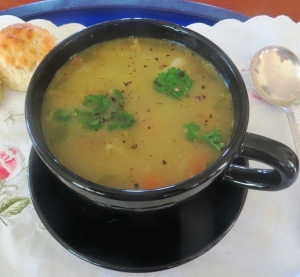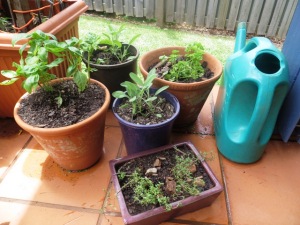Old people should eat more soup!
It’s obvious, when you think about it. As the body ages, the ability to digest food diminishes. Older people often complain about dyspepsia and are – not surprisingly – the major consumers of anti-indigestion medicines. In an age where most people, except those who live in dire poverty, eat too much and too often, digestion problems are the price we pay for affluence. So we need to satisfy our appetites with food that is easier for our bodies to process. Soup, in which solid food is reduced by thorough cooking to an easily digestible form, is thus the ideal meal.
For a start, even a thick soup is mostly liquid and the human digestive track has no problem processing water. But there is a lot more to it than that.
1. Only the very young and those doing hard physical labour can eat large quantities of food without ill effect. The older you get, and the more sedentary your habits, the less you need to eat. What’s more, you need to reduce the amount of food you eat at any one meal because the digestive system just can’t process it effectively. Though our appetites DO tend to diminish with age most of us still tend to eat too much. Yet if you are, say, 65 years old and you set out on a plate the ideal amount of food your body requires for dinner, it would look very meager indeed. Unless this meal consisted, of, say, a small piece of grilled chicken and salad, even a modest meal involving a portion of meat, vegetables and carbohydrates such as rice and pasta, would be more calories than your body can use and in a form that you can’t easily digest. One big advantage of soup is that it turns a small amount of solid matter (meat, vegetables, grains) into a meal that gives you all the nutrition you need and still satisfies the stomach. A bowl of hearty soup makes you feel full at once. Two bowls is more than most of us can handle. But the amount of food we’ve actually eaten is small in comparison with any other meal. That piece of grilled chicken and salad will probably give you about the same number of calories/kilojoules. But except in hot weather you won’t find it very satisfying. And who wants to eat chicken and salad every day?
2. Salad, in any case, is not always easily digestible for older people, especially those with health problems. Contrary to some fashionable opinion, raw food is NOT always good for you and can be downright harmful. A lot of the vegetables that we commonly eat today would not have been eaten by our distant ancestors because without cooking such foodstuffs would not have been considered either palatable or digestible. Even Australian Aborigines, whose hunting and gathering food habits endured into the beginning of the last century, had developed highly complex ways of preparing foods that would otherwise have been difficult – even dangerous -to digest. We all know that fiber is good for us but it can also be very difficult for our digestive systems to process. Therefore most vegetables need to be well-cooked, especially for older people. This includes all the brassicas such as cabbage, cauliflower, Brussels sprouts and broccoli, as well as celery, beans and root vegetables. The skin of vegetables such as pumpkin, squash and eggplant/aubergine are also hard to digest and even tomato skins can cause inflammation of vulnerable parts of the digestive track. The fibers in red meat – beef and lamb – are also harder for the digestive system to break down and absorb as we age. Other difficult-to-digest foods include bread (especially very new bread), nuts and raw cereals. Cooked oatmeal is a good food for older people. Uncooked muesli is not. Soup involves long and thorough cooking which breaks down fibrous foods while still retaining nutrition, so it’s very gentle on the system.
3. Elimination of body wastes is something else that begins to falter with age. Again, the reducing of solid food to a soft consistency that doesn’t take a lot of work by your digestive processes means the bowels can function more easily. This is of course aided by the amount of water in soup, which helps (in very simple terms) to flush out your system. Plenty of fluid – not too much indigestible matter – that’s one of the secrets for healthy bowels.
4. Older people, as already stated, tend to eat too much; consuming more energy than the body can readily process without turning it into excess fat. VERY old people, by contrast, tend to lose their appetites. There is no arbitrary cut-off line here because some of us age faster than others. However for the purposes of this article, 75-80 is probably a good age line to draw between “older” and “very old” when it comes to human appetite and digestion. People in the latter group will often tell you that they have lost all interest in food because they don’t seem to be able to taste it with the same pleasure and intensity. And, let’s face it, much of our eating is done not for the necessary nutrition but because it gives us such sensual pleasure – that’s why we have taste buds! Thus soup is the ideal food for the very old because it’s easy for fading appetites to manage, and easy to eat, too. And a bowl of steaming, aromatic soup tempts the taste buds like nothing else can. All the necessary nutrition in the world can be packed into it.
5. Finally, soup is very easy to make. And economical. It can be made in a large amount, if necessary, then divided into portions and frozen . For elderly people, living along, or those who care for them, this is a big bonus.
You can’t age gracefully if you are overweight and your digestion is playing up – so more soup in the diet is a good bet for becoming the fittest and feistiest 90 year old around.
If all this interests you then you might like to read my book Slim with Soup which has a lot more information on the virtues of soup for older people, plus a few handy recipes. Details are on this website and you can buy the book at http://www.amazon.com/gp/reader/B00B2GX3DC/ref=sib_dp_kd#reader-link. It’s only $3.99, downloaded to your Kindle or to your PC.






